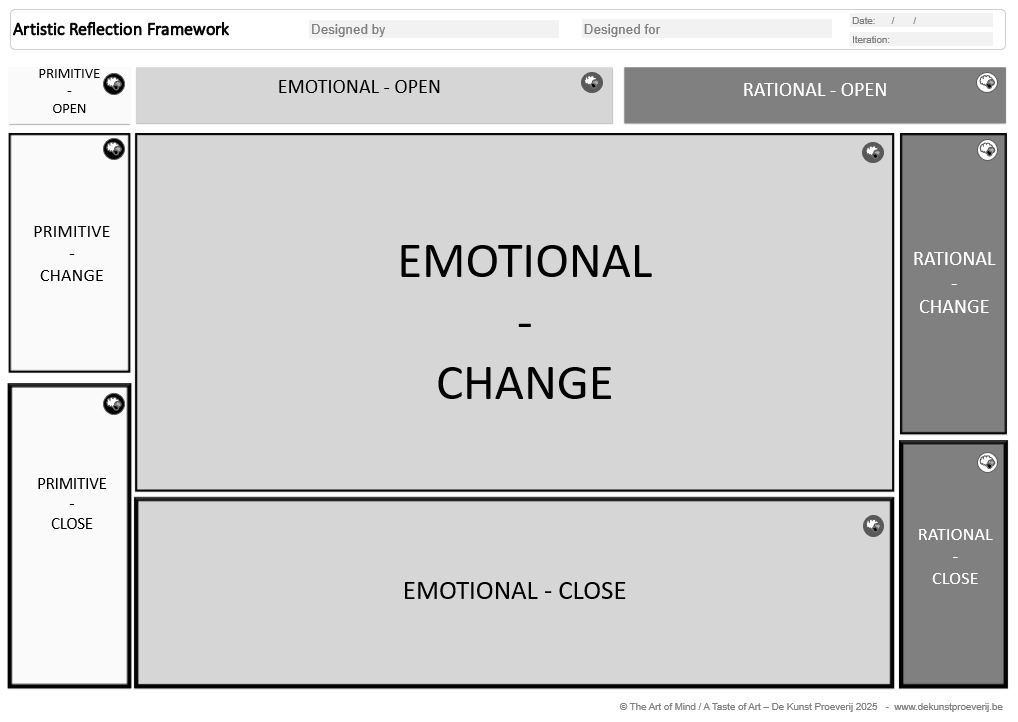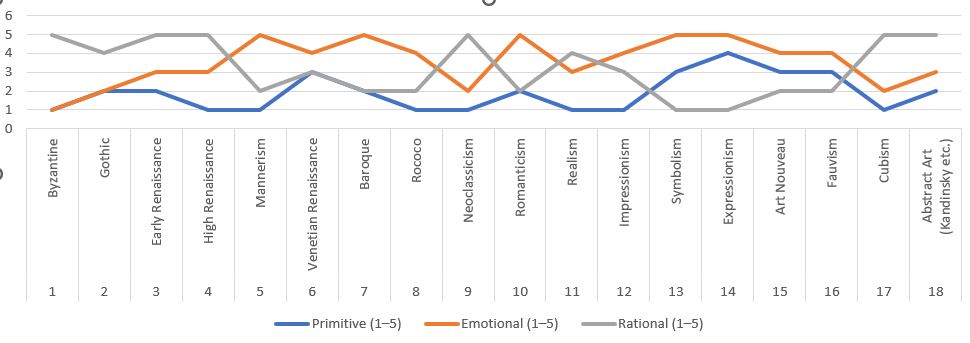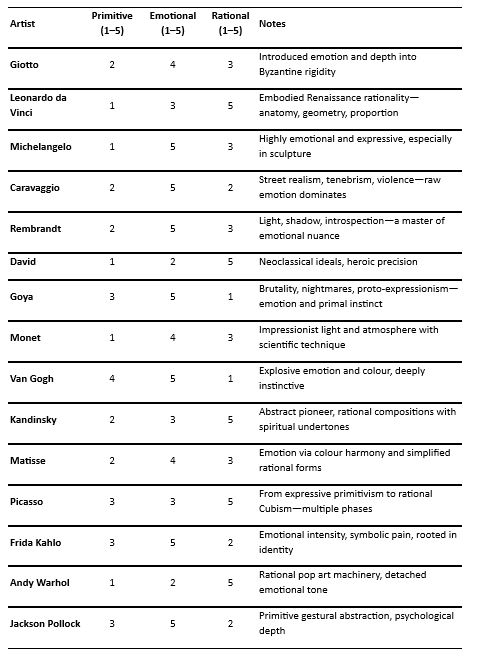Key Insights on 'The Artistic Reflection Framework' – Summary
Key Insights on 'The Artistic Reflection Framework' – Summary
In the past episodes (1 to 15) I have introduced the main concept of the 'Artistic Reflection Framework'. Before going into detail on different in depth aspects of each of the brain key reflection regions, I'd like to summarize and visualize this reflection tool and also echo on its use.
Key message
This framework can be a guidance tool for artistic self-reflection, to get deeper insights in and grip on personal artistic DNA and environments, but also to allow understanding and following artist's thoughts and visions and align between and within artistic individuals or groups.
Key applications
Determine personal profiles: "What is your artistic thinking DNA?"
As an art lover or practitioner
How do I look, think, feel, resonate when looking at art or making art?
How can you learn from your personal insights?
How is this personally translated into looking at, appreciating or making art?
As an artist
What are your key artistic thinking assets?
How can it help others to understand your artistic work, without having to
explain it?
As an art curator & artistic leader
What guides your
key artistic ways of thinking?
What is the artistic DNA of your team members?
Determine the artistic group DNA: "What is your joined artistic thinking?"
Art Gallery
What artistic DNA do you stand for?
How can you use this to match with (potentially new) artists?
Art Museum
Which artistic thinking features or assets do you apply and how?
What does your museum stand for from an artistic thinking perspective?
How can you resonate or align (better) with your audiences?
How can I help and create value for you (and why me)? My unique profile combines …
Art Practice
I understand
artists as I am a painter myself, you need to know the 'metier' from inside out
Art Knowledge
I understand art, as an art collector, and have a keen interest in art and art
history
Scientific Background
I'm scientifically
sound (over 25 years of academic experience), have broad knowledge and
understanding of sciences (neurosciences, psychology, behaviour, biology, (neuro)marketing,
economics & leadership, …) and can explain and translate complex art
related research findings and brain research into practice
Excellent Guidance Experience
After years of
experience in guiding groups, developing concepts & hands-on tools, giving
inspiring presentations, providing interactive sessions to peers, researchers
and public and following art academy myself, I am perfectly positioned to facilitate,
provide support and guide group sessions of interest in multiple ways (from
practical art ideation to deep dive into reflection guidance in practice)
See homepage for concrete ways of support and contact information
Key Insights on 'The Artistic Reflection Framework' - Summary
As mentioned in the previous episodes, the dimension of the three brain thinking areas and the dimension of the brain process phases leads to a matrix construction, as visualized below.

In the crossings of each of these components, brain reflection areas are determined under each combination. The 2-D visualization is, as previously explained, similar to the 'Business Model Canvas' by Osterwalder, meant for entrepreneurs to reflect on the most important key elements of their business idea or enterprise, in order to possibly improve the business strategically. As for this artistic model, also here this 'canvas' is meant to reflect (and possibly improve?) your or our understanding of any related artistic context. As in Osterwalder's model, where there are specific connections between key areas, there are also here connections between artistic brain areas. In essence, the artistic framework aims to get a better grip on or understanding of the 'artistic DNA' of an artist (or any other individual in the artistic ecosystem) and the interactions between people in these ecosystems.When taking into account the 'weight' (or total numbers of the different brain factors, which will be explained later into detail) in each of these quadrants, the reflection tool can be represented based in this way.

As you can notice, these areas have different total of brain factors, more weight is present in the EMOTIONAL brain thinking axis than in the PRIMITIVE or RATIONAL brain thinking. Within the horizontal phases, most factors are situated in the CHANGE phase. This is not unsurprising as in human behaviour, thinking and doing, our emotions are the primary and most important influential effectors, consciously or unconsciously. In addition, there is more change in our ways thinking than initiation or consolidation.
As mentioned before, on top of these two dimensions we can add an additional dimension based on 'I - Individual', a 'WE' and an 'US' level, making it possible to tailor the artistic framework at a personal (art lover, artist, gallery owner, curator, …), a person-to-person (any combination of the personal levels), or a group (e.g. gallery, art market or museum ecosystem) level.
In a final stage, like for all living organisms, we can dedicate 'energy' (e.g. an estimated number) to each of these areas (or to the brain factors related to those areas). There is no limitless power available to determine your artistic DNA, so there must be some kind of limit that each person (or any other interaction level) has which determines the total pool of 'DNA' present.
Purpose?
In order to define a way of 'common language', the artistic reflection framework can offer a guidance as to understand how artists, art collectors, art curators or similar individuals or groups in this ecosystem think and to identify what their 'artistic DNA' is. By using the framework and its components (the 37+ brain factors – still to be uncovered), it is possible to identify artistic 'settings' based on activity levels or expression determinants of these human brain factors & processes within the given matrix dimensions. Just like DNA is expressed in living organisms, making it what they are and how they behave.
This not only makes it possible to identify intrinsic artistic properties or ways of thinking of artistic identities but also to align different ways of thinking in order to better understand or even 'compare' them.
As far as I know there is no 'common denominator framework' as similar as this on personal or group reflection, in this case within an artistic context or movement. There are, within HR and leadership contexts, existing profiling instruments or tools (De Bono hats, MTBI, DISC, Jung psychology, etc…) and all kinds of assessments (360, etc), but these goes way beyond this context or purpose (out of scope) and they are intrinsically built on other insights or properties.
Some cases presenting the application 'power' of the reflection framework…
Question 1: Are there differences in brain thinking levels in different Western Art Periods?
Using CoPilot, I asked, based on a summary document describing different artistic periods in time, to what extent each art period is defined by primitive, emotional or rational ways of thinking and to give a score on 5 for each way of thinking in each period, relatively over all 18 periods and on average.
This is a graphical representation of the outcome:

Primitive thinking levels seems to have evolved low and consistently throughout Western art periods. It stays relatively subdued across most periods, slightly surfacing in Symbolism, Expressionism, and Fauvism. This might suggests that primal, instinctive element - such as raw symbolism or ritual motifs - are typically less central in Western art, emerging mainly in modern rebellion against classical norms. Emotional thinking levels have high variability over different art periods. Peaks are noticeable during Baroque, Romanticism, Symbolism, and Expressionism, indicating cycles of intense emotional focus. This might be interpreted in a way that emotional intensity tends to rise during periods of sociopolitical upheaval or philosophical questioning. For example, the Romantic and Expressionist periods reflect deep responses to industrialization, war, and existential doubt. Rational thinking levels seem to be dominant and stable. The scores are high in Byzantine, Renaissance, Neoclassicism, Cubism, and Abstract Art periods. It might be that rationality is a kind of backbone in Western art, aligned with humanism, scientific advancement, and formal aesthetics. Artists often return to logic and geometry when redefining visual language.
You might say that Western visual art zigzags between feeling and thinking, with brief flirtations toward instinctual or "primitive" mode - especially when rejecting academic norms or embracing the subconscious. Emotional movements are often responses to rational ones, creating a dynamic rhythm in the visual canon.
Question 2: Are there differences in brain thinking levels for specific known artists during these periods?
Like for periods in art history, can we map individual artists across the primitive, emotional, and rational spectrum to better understand their artistic mindset and how they reflect or reshape historical tendencies? It's like creating a psychological fingerprint for each artist through their work, this was the outcome CoPilot provided …
Artist Analysis Based on Thinking Styles …

These scores are relative and interpretive, aiming to spark reflection rather than create absolutes. Artists often defy categories - just like people do.
I asked AI if these scores of these individual known artists correlate with the scores of the periods in which they created their art. It (off course) confirmed this was the case and added some comments: Artists with a more 'rational' thinking signature like Leonardo da Vinci, Raphael, David, and Warhol all scored high on rationality and lived during Renaissance, Neoclassicism, or Modernism, where precision, logic, and theory were paramount. These artists often embodied the ideals of order, proportion, and conceptual structure that their eras celebrated. Primarily 'emotional' inspired artists like Caravaggio, Rembrandt, Goya, Van Gogh, and Pollock scored high on emotion and coincided with Baroque, Romantic, or Expressionist periods. They served as vehicles for the inner turmoil, passion, and existential themes that defined their cultural moment. Finally, 'primitive' thinkers in anti-academic movements like Van Gogh, Dubuffet, Kahlo, and Pollock scored higher on primitive modes during periods that rejected institutional norms (Symbolism, Expressionism, Outsider Art). Their work channelled instinct, raw symbolism, and emotive gesture, often in rebellion against prevailing rational or academic art.
Fascinating cases where artists who depart from their period's norms, either partially or radically. Picasso for instance straddled primitivism, rationality, and emotion, moving from African-inspired forms to Cubist geometry. Or Kandinsky in the abstract era who scored high on rationality, but infused his work with spiritual emotion, showing that artists can synthesize or subvert dominant styles. So it is not at all a straightforward story and changes during lives of artists also occurred, as did periods, and sometimes both together.
Some food for thought ....
-------------------------------------------------------------------------------------------------------------------------
'The Art Of Mind' - An Artistic Reflection Framework
Coming up next: Episode 16 (... after some relaxing summer days and doing some catchin up with art work!)
For the previous published blogs, please check homepage link below.
Want to follow 'A Taste of Art' experience?
Subscribe, keep being informed or get in contact!
© De Kunst Proeverij (DKP) (A Taste of Art) – Bruno Hoste
* Content has been generated with the help op AI *